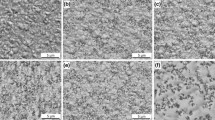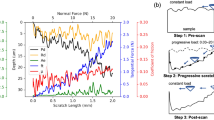The present work studied the adhesive strength and tribological performance of the multilayered Fe–Ni coating fabricated by the electroplating. The adhesive strength was quantified by a novel modified Ollard method. The cross-section morphology and inherent mechanical properties of each layer were analyzed. The tribological performance of the developed coating was compared with the common used BP alloy cast iron. The effect of the treatment of dimple texturing coupling with the MoS2 on friction reduction of the Fe–Ni coating was investigated. The results show that the adhesive strength between the Fe–Ni coating and the 42CrMo substrate is as high as 460 MPa. The repeatable results validate the applicability and stability of the developed adhesion quantification method. The initial layer, transition layer and hard Fe–Ni layer can be observed in sequence from the substrate to the coating surface. Accordingly, the hardness and residual stress in different layers varies with different layers. The tribological properties of the Fe–Ni coating are better than the common used BP alloy cast iron, such as the lower friction coefficient and less wear loss as well as much longer anti-scuffing time. The treatment of dimples textured surface and then filled with MoS2 nano particles can even improve the tribological performance of the Fe–Ni coating due to the coupling effect of the dimples and MoS2 particles.











Similar content being viewed by others
References
M. N. Regul’skii, A. D. Pogrebnyak, and O. B. Balakovskii, “Procedure and results of investigation into fatigue strength characteristics of motorcycle engine crankshafts,” Strength Mater., 34, No. 6, 629–635 (2002).
Y. Komai, Y. Takashima, T. Fujiwara, et al., Development of Horizontal Water Cooled Diesel Engine to Achieve High Power Density, SAE Technical Paper 2018-32-0064 (2018), doi: https://doi.org/10.4271/2018-32-0064.
V. Malcev, A. Bozhenov, R. Schwab, and M. Müther, “High power density high speed diesel,” MTZ Industrial, 6, No. 2, 14–21 (2016).
H. Zhang, T. Li, Z. Liu, and Q. Jiang, “Diesel engine block remanufacturing: life cycle assessment,” in: A. Y. C. Nee (Ed.), Handbook of Manufacturing Engineering and Technology, Springer, London (2015), pp. 3313–3341.
M. Karbasi, F. Tavangarian, S. Vardak, and A. Saidi, “Synthesis, characterization and optimization of nanostructured Fe-Ni coatings by electrodeposition method,” Prot. Met. Phys. Chem. Surf., 49, No. 5, 548–553 (2013).
A. Sanaty-Zadeh, K. Raeissi, and A. Saidi, “Properties of nanocrystalline iron–nickel alloys fabricated by galvano-static electrodeposition,” J. Alloy. Compd., 485, Nos. 1–2, 402–407 (2009).
M. Donten, H. Cesiulis, and Z. Stojek, “Electrodeposition and properties of Ni–W, Fe–W and Fe–Ni–W amorphous alloys. A comparative study,” Electrochim. Acta, 45, No. 20, 3389–3396 (2000).
X. Hu, “Crankshaft restoration by iron plating,” Met. Finish., 95, No. 6, 98–100 (1997).
W. S. Lei and A. Kumar, Adhesion Measurement of Thin Films and Coatings: Relevance to Microelectronics, in: K. L. Mittal and Tanweer Ahsan (Eds.), Adhesion in Microelectronics, John Wiley & Sons (2014), pp. 33–63.
J. Rigelsford, “Welding of plastics: Core research from TWI,” Assembly Autom., 23, No. 2 (2003), doi: https://doi.org/10.1108/aa.2003.03323bae.003.
D.-C. Han and J.-S. Lee, “Analysis of the piston ring lubrication with a new boundary condition,” Tribol. Int., 31, No. 12, 753–760 (1998).
S. C. Tung and M. L. McMillan, “Automotive tribology overview of current advances and challenges for the future,” Tribol. Int., 37, No. 7, 517–536 (2004).
S. Ma, W. Chen, C. Li, et al., “Wear properties and scuffing resistance of the Cr–Al2O3 coated piston rings: the effect of convexity position on barrel surface,” J. Tribol., 141, No. 2, 021301 (2018), doi: https://doi.org/10.1115/1.4041215.
V. Torabinejad, M. Aliofkhazraei, A. S. Rouhaghdam, and M. H. Allahyarzadeh, “Tribological properties of Ni-Fe-Co multilayer coatings fabricated by pulse electrodeposition,” Tribol. Int., 106, 34–40 (2017).
U. Sudeep, N. Tandon, and R. K. Pandey, “Performance of lubricated rolling/sliding concentrated contacts with surface textures: a review,” J. Tribol., 137, No. 3, 031501 (2015), doi: https://doi.org/10.1115/1.4029770.
N. Tala-Ighil, M. Fillon, and P. Maspeyrot, “Effect of textured area on the performances of a hydrodynamic journal bearing,” Tribol. Int., 44, No. 3, 211–219 (2011).
J. J. Wagner, A. D. Jenson, and S. Sundararajan, “The effect of contact pressure and surface texture on running-in behavior of case carburized steel under boundary lubrication,” Wear, 376–377, 851–857 (2017).
T. W. Scharf and S. V. Prasad, “Solid lubricants: a review,” J. Mater. Sci., 48, No. 2, 511–531 (2013).
B. Chen, X. Li, Y. Jia, et al., “Tribological properties of Fe–Ni-based composites with Ni-coated reduced graphene oxide–MoS2,” J. Compos. Mater., 52, No. 19, 2631–2639 (2018).
Y. Shen, Y. Lv, B. Li, et al., “Reciprocating electrolyte jet with prefabricated-mask machining micro-dimple arrays on cast iron cylinder liner,” J. Mater. Process. Tech., 266, 329–338 (2019).
Acknowledgments
The work was supported by the Fundamental Research Funds for the Central Universities of China (017180205).
Author information
Authors and Affiliations
Corresponding author
Additional information
Translated from Problemy Prochnosti, No. 2, pp. 129 – 141, March – April, 2019.
Rights and permissions
About this article
Cite this article
Huang, R.X., Ma, Z., Dong, W.Z. et al. On the Adhesive Strength Quantification and Tribological Performance of the Multilayered Fe–Ni Coating Fabricated by Electroplating. Strength Mater 51, 280–290 (2019). https://doi.org/10.1007/s11223-019-00074-9
Received:
Published:
Issue Date:
DOI: https://doi.org/10.1007/s11223-019-00074-9




